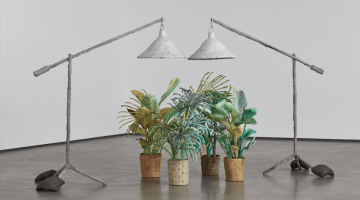Evan Nesbit & Kate Bonner
All the work in the show Practicing to Pretend, curated by Melissa Dickenson and William Emmert now up at Alter Space through August 17, offers a way for contemporary painting to address how perception has been changed by our interaction with digital devices. The artists / curators seem to be suggesting that the flat surface of the painting is no longer reserved for the singular presentation of two dimensional space, but instead like the familiar screens and monitors provides a conduit between real and virtual space. This is especially evident in the work of Evan Nesbit and Kate Bonner, as they take on the surface in separate and complimentary ways. Nesbit’s work engages painting as endpoint,object and continuum while Bonner’s work does the same with the viewer. The effect is work that is both discrete and immersive.
Three acrylic on burlap paintings by Evan Nesbit are included in this show Fingered, Fingered3 and Porosity . In all three, the material is pushed up through the warp and weft of the burlap to create little pustules of acrylic paint. With this simple direct act, the traditional surface of the painting is turned away from us. This perceptual shift suspends the space of the painting becoming ambiguous enough to be all space or no space; it is an object in our space or an illusion of space on an object that we can see and interact with but not physically access. Gentle furrows pushed back into the impasto paint by the artist’s fingers are the only marks on two of the pieces, they are neither tentative nor gestural. What they do, is meet in the middle exposing the burlap as a secondary surface and pivot point trapped in the matrix of paint, flatness, illusion and space.
There is an interior/exterior presence created by the two pieces from Kate Bonner, and both works project is to mediate between them. Both pieces are digital prints on MDF board cut into sections, simple prints of a forest that are not actually simple at all. In A Half Open Interval a single print is cut into four parts leaving enough visual information to suggest the familiar anonymousness of trees. It is the fragmented banality of the image that places it emphatically between the interior intimate space of art and the exterior shared space of the object. In mathematics a half open interval is a set of numbers that contains an upper or lower endpoint but not both, the suggestion here being that the piece is one visual endpoint and that it is up to the viewer to supply the other. The second piece, The Space Between Things has a single curved cut up from the bottom left which makes the lower right corner appear absent. One of the printed images overlaps and obscures the other; the only time the tilting folding images interact with the edge of the object is in the interior cut. The impression here is that of an image of images contained by the shallow space of illusion. We cannot no matter how long we look fill in the blank or see the entire more distant image and so the visual interval remains open and ready for investigation.
For more information visit here.
-Contributed by Matthew Marchand




